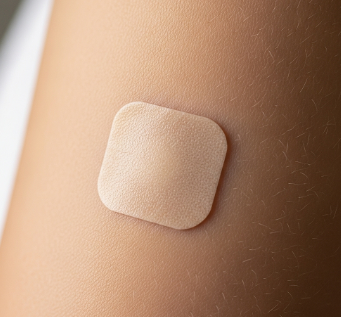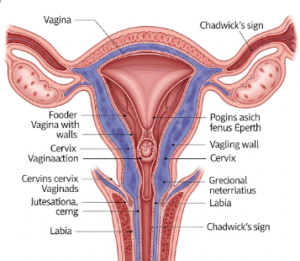Overview
The contraceptive patch is a transdermal hormonal method for preventing pregnancy. It is a small adhesive patch applied to the skin that releases estrogen and progestin to suppress ovulation, thicken cervical mucus, and alter the uterine lining, preventing fertilization and implantation.
Importance of the contraceptive patch:
- Highly effective with ~99% efficacy when used correctly.
- Convenient weekly application avoids daily pill administration.
- Reversible, allowing fertility to return quickly after discontinuation.
- Can regulate menstrual cycles and reduce dysmenorrhea in some users.
In South Korea, contraceptive patches are available by prescription in gynecology clinics and hospitals, with healthcare professionals providing counseling on proper use, side effects, and follow-up care.
Why It’s Done
The contraceptive patch is used for preventing pregnancy and may also offer additional menstrual or hormonal benefits.
Common indications include:
- ➤ Women seeking weekly, convenient contraception instead of daily pills.
- ➤ Individuals preferring reversible contraception with minimal daily attention.
- ➤ Management of menstrual irregularities, cramps, or hormone-related acne.
- ➤ Women who cannot adhere reliably to daily oral contraceptives.
- ➤ Temporary spacing of pregnancies for health, lifestyle, or personal reasons.
Benefits for users:
- ✔️ High efficacy when applied on schedule.
- ✔️ Weekly application is simple and discreet.
- ✔️ Rapid return of fertility upon discontinuation.
- ✔️ Can help regulate menstrual cycles and reduce menstrual pain.
- ✔️ Provides reliable protection from unintended pregnancy.
Alternatives
While the contraceptive patch is effective, alternatives include:
- ➤ Oral contraceptive pills: Combined or progestin-only.
- ➤ Contraceptive injections: 1–3 month hormone-based shots.
- ➤ Contraceptive implants: Long-acting, subdermal rods.
- ➤ Intrauterine devices (IUDs): Hormonal or copper IUDs.
- ➤ Barrier methods: Condoms, diaphragms, cervical caps.
- ➤ Permanent sterilization: Tubal ligation or vasectomy.
- ➤ Fertility awareness methods: Calendar tracking, basal temperature, or cervical mucus monitoring.
Key point: The patch is ideal for women who want reliable, weekly contraception with minimal daily attention.
Preparation
Proper preparation ensures safe and effective use.
Steps include:
- ✅ Medical consultation: Review medical history, hypertension, cardiovascular risk, and smoking status.
- ✅ Patient education: Explain application site rotation, schedule, effectiveness, side effects, and backup contraception if a patch is missed.
- ✅ Consent: Ensure patient understands risks, benefits, and alternatives.
- ✅ Application site preparation: Clean, dry, and hair-free skin on buttock, abdomen, upper arm, or back.
- ✅ Backup contraception: Use condoms for the first week if starting the patch mid-cycle or after missed periods.
Important: Proper preparation ensures maximum efficacy, minimal side effects, and informed decision-making.
How It’s Done
The contraceptive patch is a simple, outpatient method applied by the user at home once a week for three weeks, followed by a patch-free week.
Procedure steps:
- Select a clean, dry, hair-free site: Buttock, abdomen, upper arm, or back.
- Remove the protective backing and apply patch firmly.
- Wear for 7 days, then replace with a new patch on the same day of the week for three consecutive weeks.
- Fourth week: Patch-free to allow withdrawal bleeding.
- Rotate application sites weekly to avoid skin irritation.
Duration: Provides continuous contraception as long as the patch is applied weekly.
Hospital stay: Not required; self-administered at home after counseling.
Key point: The patch is user-friendly, reversible, and highly effective when used consistently.
Recovery & Post-Use Care
No medical recovery is required, but ongoing care ensures safety and efficacy.
Immediate care:
- Monitor for skin irritation, redness, or mild itching at the application site.
- Avoid applying lotions or oils that may reduce adhesion.
Short-term care:
- Track menstrual patterns and any side effects (nausea, headaches, breast tenderness).
- Replace patch on schedule and monitor for dislodgement or falling off.
Long-term outcomes:
- Continuous pregnancy prevention with minimal daily attention.
- Menstrual cycles normalize quickly after discontinuation.
- Side effects are generally mild and manageable, such as spotting or mild hormonal symptoms.
Important: Proper adherence and site rotation ensure sustained efficacy and minimal adverse effects.
Possible Complications / Risks
The contraceptive patch is generally safe but may have minor complications or side effects:
- ⚠️ Skin reactions: Redness, itching, or rash at the application site.
- ⚠️ Hormonal side effects: Nausea, headaches, breast tenderness, or mood changes.
- ⚠️ Cardiovascular risks: Slightly increased risk of blood clots, especially in smokers over 35.
- ⚠️ Dislodgement or adhesion failure: Can reduce contraceptive efficacy.
- ⚠️ Menstrual irregularities: Spotting or breakthrough bleeding during initial cycles.
In South Korea, contraceptive patches are regulated and prescribed by trained gynecologists, with counseling on proper use and monitoring for side effects.
Treatment Options / Clinical Relevance in Korea
The contraceptive patch is a modern, convenient contraceptive option in South Korea, particularly for women seeking weekly hormone-based contraception.
Key features:
- 🏥 Available by prescription in gynecology clinics, hospitals, and family planning centers.
- 🏥 Suitable for women seeking reversible contraception without daily attention.
- 🏥 Integrated into sexual and reproductive health counseling.
- 🏥 Allows flexible family planning and spacing of pregnancies.
- 🏥 Minimal healthcare oversight needed after counseling and initial instruction.
Highlights in Korea:
- ✔️ Weekly application is user-friendly and discreet.
- ✔️ Provides highly effective contraception (>99% when used correctly).
- ✔️ Supports menstrual regulation and reduces dysmenorrhea for some users.
- ✔️ Adverse effects are manageable under medical supervision.
- ✔️ Fertility returns rapidly after discontinuation, ensuring reversible family planning.
Highlights
- ➤ Contraceptive patch is a weekly, hormone-based method for pregnancy prevention.
- ➤ Indicated for women seeking reversible contraception with minimal daily attention.
- ➤ Alternatives include pills, injections, implants, IUDs, barrier methods, sterilization, or fertility awareness.
- ➤ Preparation involves medical consultation, counseling, consent, and proper skin site selection.
- ➤ Application is weekly for three weeks, followed by a patch-free week, rotated across sites.
- ➤ Recovery is immediate; minor skin irritation or mild hormonal effects may occur.
- ➤ South Korea provides regulated access with counseling, monitoring, and medical support.













